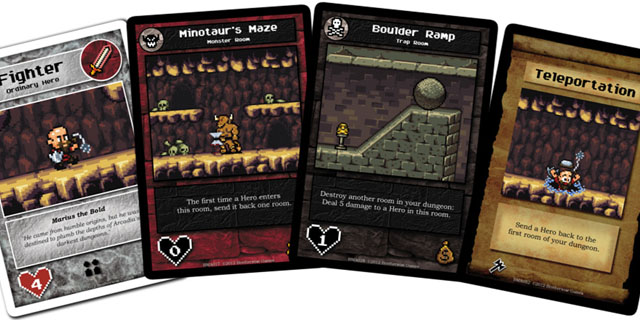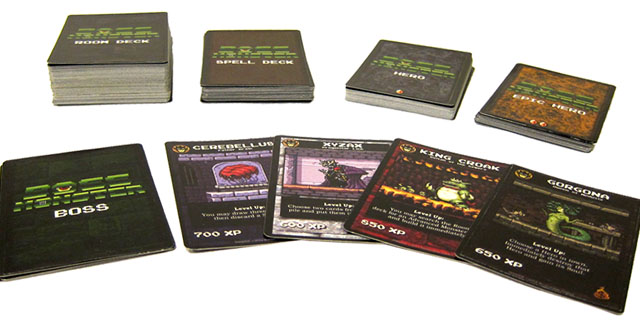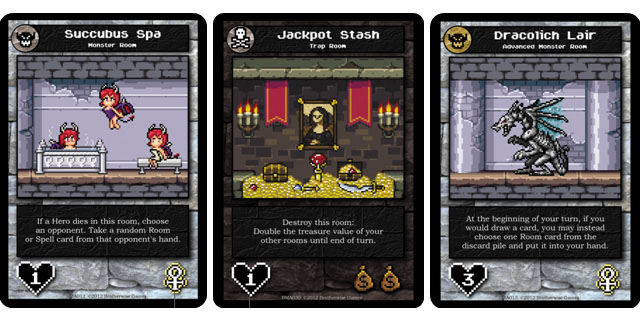
If it had any other theme, over 4,000 backers (myself included) probably wouldn’t have even noticed Boss Monster, the first offering from indie developer-publishers Brotherwise Games. But the love Johnny and Chris O’Neal have for the retro video games of our shared youth had infused their creation with the right amount of nostalgia to catch the attention of enough to completely destroy their funding goal, earning nearly 18 times their desired target. The pixel-art aesthetic extends beyond mere card art, as even the box design, instruction manual and PDF “strategy guide” are reminiscent of old-school NES offerings. Playing Boss Monster might not feel like playing a tabletop version of a video game, but it certainly looks the part from head to toe.
Up to four players are each randomly assigned a Boss Monster identity from the deck of eight possible choices (nine for the first print run). Each Boss has a treasure type, Level-Up ability, and an XP value that will be used to determine turn order. They are then dealt two Spell cards and five Room cards, discarding two cards of their choice before selecting a Room to build to the left of their Boss. Rooms come in two types, monster or trap, and can be either basic or advanced. Advanced Rooms can only be built on top of an existing Room that has a matching treasure type, but basic Rooms can be built on top of anything or used to extend your dungeon to a maximum of five Rooms.
The goal of Boss Monster is to collect ten Souls by luring unwary Heroes into your dungeon to face their destruction. A number of Hero cards equal to the number of players are turned face-up in the center of the table (“the town”) at the beginning of each round. These Heroes come in the four classic types (fighter, thief, mage and cleric), and normally have either four, six or eight hit points. Should the regular Heroes become exhausted before the game ends, Epic Heroes with eleven or thirteen hit-points will start showing up; Epic Heroes are worth twice as many Souls, but also carry twice the risk. You see, any Hero that survives your obstacle course will instead inflict a Wound upon you, and Epic Heroes inflict two. Should you accumulate five Wounds, you are eliminated, so be sure you are ready for these game-changers before they show up.

Each turn you get to draw and build one Room card. Each Room has a number indicating the amount of damage it inflicts on any Hero that enters it, one or more treasure types and usually some sort of special ability that will come in handy. These treasure types indicate what type of Heroes are lured to your dungeon during the Bait Phase. Whoever has the most Spellbooks, for example, will lure all of the mages in town to their dungeon. If there is a tie, those Heroes remain in town for that round, and will be re-evaluated on subsequent rounds until they are finally lured somewhere. Lured Heroes will run through your dungeon during the Adventure Phase, suffering damage until they either die or make it to the Boss and inflict a Wound. (For some reason none of the current Bosses are able to damage Heroes on their own, which is one of the few times the game mechanics don’t quite resonate with the theme.)
While that is mostly as straightforward as it sounds, there are complications. Spell cards are the primary source of these, as they can increase damage dealt by a Room for the turn, make Heroes tougher, deactivate Rooms entirely or any number of other effects. Spell cards can be difficult to acquire, as mostly only Mage Rooms provide them, but their effects are almost always worth it. Not that other rooms are without their merits! Fighter Rooms tend to deal more damage and draw you additional Room cards, Thief Rooms can often sacrifice themselves or other rooms to deal additional damage or even outright kill a Hero, and Cleric Rooms usually force other players to discard cards from their hands or let you retrieve cards from the discard pile. And of course, the Bosses themselves aren’t completely helpless. Once per game, when you build your fifth room onto your dungeon, your Boss Monster’s Level-Up ability triggers. Each of these effects is unique, but they all provide a crucial edge in your quest to accumulate Souls.
As stated, the game ends when one or more players has acquired ten or more Souls without suffering five or more Wounds. In the event of more than one player reaching this goal, regardless of actual amount (e.g., twelve Souls does not automatically beat ten), the number of Wounds each has received is subtracted from their Soul count to determine the winner (at which point twelve does beat ten), with ties favoring the Boss with the lower XP total.

For the most part, playing Boss Monster is a matter of managing your treasure types and making sure that you have enough damage in your dungeon to avoid taking too many Wounds. Early on, it might be worth it to attract Heroes that you cannot defeat, as every Wound you suffer is at least one Soul someone else hasn’t earned. That strategy obviously only works for so long, although I have yet to see a player be eliminated by Wounds. Most of your strategy is going to be determined by the luck of several draws: your Room cards, everyone’s Spell cards and whatever Heroes show up when. That is a lot of randomness, but the game is quick (under 30 minutes once you are familiar with the cards) and light enough that this isn’t usually a big issue.
The hardest parts of the game are the timing rules for the Build and Adventure Phases, which are mostly determined by Boss XP value but trumped by being the active player. Those will take some getting used to, and you will probably play the game incorrectly the first couple of times, although that shouldn’t impact your enjoyment. If you want to increase the challenge, you can shift to “hard mode” by removing all of the four hit-point Heroes from the deck, which will both make Heroes harder to kill in general and bring the Epic Heroes online sooner.
As a card-based game, Boss Monster is easily expandable, and most Kickstarter backers have several exclusive cards in their mix for additional variety. An official expansion, Tools of Hero Kind, is already in development, but the base set (Master of the Dungeon, officially) is plenty playable on its own. It should be available as you read this, and retails for $25. It isn’t going to be winning any awards for strategic complexity, but Boss Monster is quality filler with a theme that will appeal to a much wider audience than most tabletop games. If you are part of that audience – and if you’re reading this site, you probably are – it’s an easy recommendation.



















